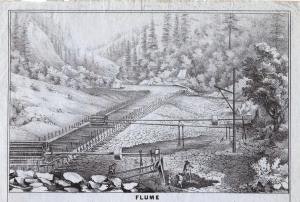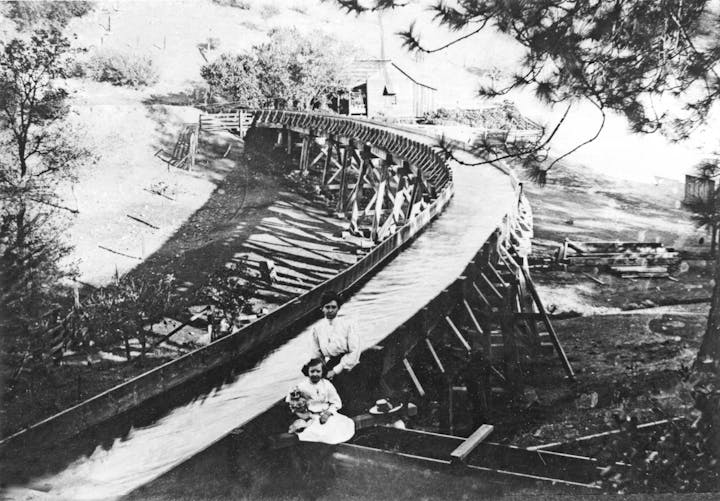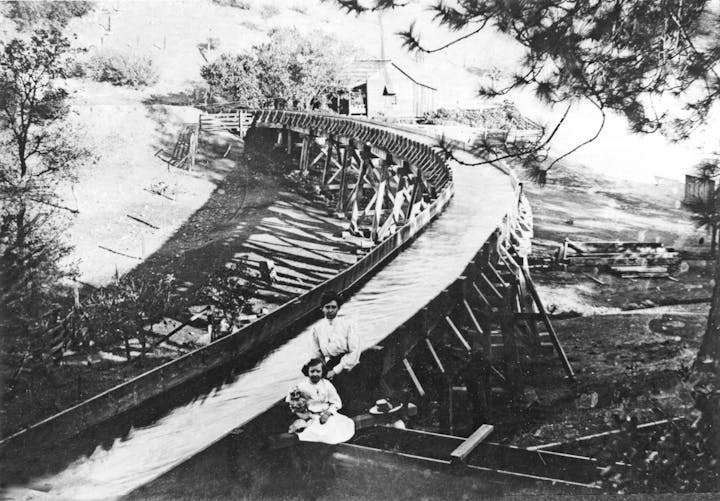Water, Dams, and Ditches

Water has always been, and continues to be, of major importance in the development of Calaveras County. From the early days of mining, ditches diverted water to the diggings and allowed for the establishment of camps and towns. Both local and outside interests tapped county water for hydroelectric power generation, while the expansion of agriculture and demands for domestic water supplies made this “liquid gold” ever more precious. Modern reservoirs bank this wealth for not only Calaveras citizens, but for populations further west.
As foothill rivers are seasonal and unpredictable, and water is essential to the recovery gold, original mining took place along the rivers and their tributary streams. It wasn’t long, however, before entrepreneurs constructed dams, ditches, and flumes to store water and transport water between drainages. Often transitory in nature, many of these ditch systems were abandoned as the placers played out, but others were improved and extended for hydraulic and hard rock mining. The demise of hydraulic mining in Calaveras County in the early 1900s, ended the prosperity of the independent water companies. Some simply shut down, while others converted to agricultural and domestic uses.
The county’s largest and most important ditch systems—the Union Water Company, now the Angels-Utica system, and the Mokelumne Hill Canal and Mining Company, now operated by the Calaveras County Water District, continue to serve communities on either side of the county. After the demise of mining, these ditches were converted to agricultural and domestic uses, and later to the production of hydroelectric power.
The early Angels-Utica system was surveyed and built by the Calaveras County Water Company (CCWC) incorporated on November 1, 1856, with its principal place of business at Vallecito. The system took water from the North Fork Stanislaus River and, by a series of ditches, flumes, and creekbeds, delivered it to Coyote Creek, Vallecito, and Carson Hill. When the system was acquired by the Utica Gold Mining Company in the 1880s, major expansion of, and improvements to, the flumes, ditches, and reservoirs were made. After the Utica Mine was shut down in 1915, the Company shifted its focus from supplying water for mining to providing it for agricultural and residential uses. In 1946, Pacific Gas & Electric Company (PG&E) purchased the entire Angels-Utica system, and in the 1920s the route of the old CCWC system was finally abandoned.
The most important early water system in Northern Calaveras was the Mokelumne Hill Canal and Mining Company, completed from its diversion on the South Fork to Mokelumne Hill in 1852. The ditch, with a capacity of 1000 miner’s inches, was subsequently extended to Campo Seco, Camanche, and vicinities by 1859, covering a distance of 60 miles. In 1934, water rights to the Canal were acquired by the Calaveras Public Utility District (CPUD). The open ditch to Mokelumne Hill was discontinued in 1973, made obsolete by the installation of the CPUD pipeline that now brings water from Jefferson Davis Reservoir.
Mid-County, the Table Mountain Water Company, founded n 1853, first brought water into El Dorado (Mountain Ranch), Cave City, and Old Gulch, extending their system to San Andreas by 1856. Later known as the Treat Ditch, for its owner J.F. Treat, it served these communities until the 1930s.
The Georgia Ditch took water from below the head of the Table Mountain ditch on San Antonio Creek and conveyed it to the area of Fourth Crossing. Established sometime prior to 1853, by 1858 the ditch was 20 miles long, when it was serving mining camps from Calaveritas to Fourth Crossing. Acquired by the San Antonio Ridge Ditch Company, it is now used by the Sierra Ridge Academy at Fricot City and the community of Sheep Ranch.
Beginning in the late 1890s, entrepreneurs with an eye to the future began developing hydroelectric projects on the county’s rivers. The most important of these in Northern Calaveras was the 1897 Blue Lakes powerhouse, later rebuilt upstream as Electra, on the Mokelumne River near Mokelumne Hill. Now owned by PG&E, it is one of its most productive facilities.
Shortly thereafter, in the 1920s, the East Bay Municipal Utility District (EBMUD) began a long-term process of damming the waters of the Mokelumne River to provide fresh water for its commercial, industrial, and domestic users. Pardee Dam was completed in 1929, and Camanche Reservoir filled in 1962. Along the Calaveras River, farmlands and communities were condemned by the City of Stockton for the construction of Hogan Dam and Reservoir, dedicated in 1931. New Hogan Dam was completed by the U.S. Army Corps of Engineers in 1964, raising the water level for additional storage.
by Judith Marvin, 1993, 2007


